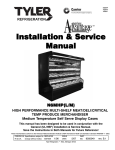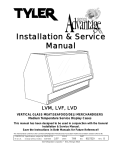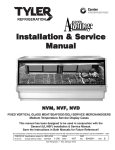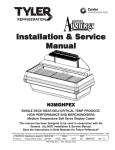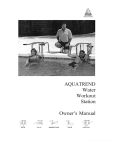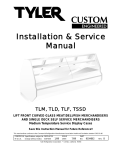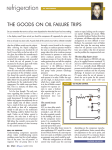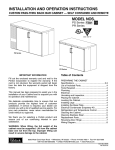Download Installation & Service Manual
Transcript
Installation & Service Manual FDESC SELF-CONTAINED FLORAL MERCHANDISER Medium Temperature Refrigerated Display Case This manual has been designed to be used in conjunction with the General (UL/NSF) Installation & Service Manual. Save the Instructions in Both Manuals for Future Reference!! This merchandiser conforms to the American National Standard Institute & NSF International Health and Sanitation standard ANSI/NSF 7 - 2003. PRINTED IN Specifications subject to REPLACES IN U.S.A. change without notice. EDITION 7/03 ISSUE DATE 5/07 Tyler Refrigeration * Niles, Michigan 49120 PART NO. 9805003 REV. A FDESC TABLE OF CONTENTS Page Specifications FDESC Specification Sheets . . . . . . . . . . . . . . . . . . . . . . . . . . . . . 3,4 Pre-Installation Responsibilities . . . . . (See General-UL/NSF I&S Manual) Installation Procedures Carpentry Procedures . . . . . . . . . . . . . . . . . . . . . . . . . . . . . . . . . . . 5 Unit Placement . . . . . . . . . . . . . . . . . . . . . . . . . . . . . . . . . . . . . . . . . .5 Controls and Defrost Information . . . . . . . . . . . . . . . . . . . . . . . . . . . . . . . 6 Electrical . . . . . . . . . . . . . . . . . . . . . . . . . . . . . . . . . . . . . . . . . . . . . . . . . . . . 6 Wiring Diagrams (FDESC Domestic & Export (60Hz) Case Circuits). . . . . . . . . . . . 7 Operation & Maintenance . . . . . . . . . . . . . . . . . . . . . . . . . . . . . . . . . . . . . . 8 Preventive Maintenance . . . . . . (See General-UL/NSF I&S Manual) General Information . . . . . . . . . . . . . . . . . . . . . . . . . . . . . . . . . . . . . . 8 Night Curtains . . . . . . . . . . . . . . . . . . . . . . . . . . . . . . . . . . . . . . . . . . 8 Draining & Condensation ................................ 9 Cleaning and Sanitation . . . . . . . . . . . . (See General-UL/NSF I&S Manual) General Cleaning . . . . . . . . . . . . . . . . . . . . . . . . . . . . . . . . . . . . . . 10 Sanitation . . . . . . . . . . . . . . . . . . . . . . . . . . . . . . . . . . . . . . . . . . . . 10 Cleaning Instructions . . . . . . . . . . . . . . . . . . . . . . . . . . . . . . . . . . . 10 Stainless Steel Cleaning Methods . . . . . . . . . . . . . . . . . . . . . . . . . . 11 Service Instructions (Troubleshooting Guide) . . . . . . . . . . . . . . . . . . . . . .13 TYLER Warranty . . . . . . . . . . . . . . . . . (See General-UL/NSF I&S Manual) Page 2 May, 2007 Installation & Service Manual FDESC SPECIFICATIONS May, 2007 Page 3 FDESC Page 4 May, 2007 Installation & Service Manual FDESC INSTALLATION PROCEDURES Carpentry Procedures CAUTION • Make sure the case is level and on a flat floor. This prevents self-contained system problems and / or premature component failure. • Do not move the case during operation. Unit Placement The FDESC Floral Merchandiser is a mediumtemperature refrigerated open self-service case that must maintain proper and consistent cooling for the sensitive floral products it displays. CASE BTUH REQUIREMENTS are calculated to produce approximately the indicated performance with absolute maximum operating ambient limits of 75°F & 55RH. The FDESC models are self-contained floral cases. These cases require flat and level floor areas for set-up and operation. Uncrate the fixture near it’s final resting place and remove from the supporting skid by lifting only from the base of the unit. The FDESC’s design does not allow for lifting or applying excess weight from the top of the unit. Take care not to not block the top vent, and discharge / return air duct areas when placing the unit. The product floor plan on the previous page has dimensional information that can aid in the unit’s store placement. The unit’s internal power, setup and maintenance components are accessed through the two rear closeoff panels, which are easily removed with a phillips-head screwdriver. The merchandiser needs to be turned on and operating at the proper temperature setting for several hours prior to stocking product. July, 2003 Rear of FDESC; Closeoff Panels removed Page 5 FDESC CONTROLS & DEFROST INFO. Controls All controls for the internal condensing unit are preset at the factory to achieve this temperature. However, it’s important to note that several environmental factors can affect the product temperature. Controls located at the top-rear of case A. B. Defrosting See the product’s specifications for defrosting information. Defrost duration times may need to be manually adjusted depending on how environmental conditions affect the unit. ELECTRICAL Defrost & Temperature Settings A. Time Clock Self-Contained Case Circuit B. Temperature Control One 208 / 230V Electrical Power Supply is required for self-contained cases. This 208 / 230V Power Supply runs a 220V circuit for the condensing unit, condensing fans, condensing pan heaters. A 120V circuit supplies the evaporator fans, exhaust fan, water pump, and lights. Master Power Switch Prior to working within the internal part of the case, always shut the unit’s power down first by throwing the Master Switch into the “Off” position. WIRING DIAGRAMS ELECTRICIAN NOTE - OVERCURRENT PROTECTION 120V circuits should be protected by 15 or 20 Amp devices per the requirements noted on the cabinet nameplate or the National Electrical Code, Canadian Electrical Code - Part 1, Section 28. 208V defrost circuits employ No. 12 AWG field wire leads for field connections. On remote cases intended for end to end line-ups, bonding for ground may rely upon the pull-up bolts. The following wiring diagram on page 7 will cover the FDESC case circuits. Page 6 Master Power Switch May, 2007 May, 2007 Page 7 FDESC Load Line OPERATION & MAINTENANCE General Information 1. This merchandiser has been designed exclusively to display floral arrangements. It is not designed for displaying or storing food products. Night Curtain 2. The fiberglass drain pan (bottom floor of the case) is suitable for placing display vases. However, it is not designed to support the weight of a person, or a concentrated load such as from a ladder or a display stand. Misuse of the drain pan may cause puncturing or cracking, leading to leakage. 3. To maintain a longer product life, and to maintain optimal performance of the case: a. Keep all products within the load lines. b. Do not clog or block the return-air ducts (slots located just above the drain pan) Return-air duct c. Be careful not to place large signage in air discharge or air return areas. This throws off the case’s intended airflow. d. Do not use supplemental lighting. The emitted lighting in the case is balanced to maximize product life. Night Curtains The FDESC merchandiser has a series of pulldown clear vinyl curtains located at the top of the unit’s canopy. These are for controlling the direction and amount of cool air within the unit. As an energy efficiency device, they may be pulled down overnight to keep the cool air in the unit longer. Night Curtains They can also be partially pulled down as needed in areas where product is not being merchandised. Page 8 May, 2007 Installation & Service Manual FDESC OPERATION & MAINTENANCE Draining & Condensation The Drain Pan has been designed for the purpose of removing water that occurs due to normal operation of the refrigeration system. It should not be used to dump excess water, nor be used as a drain for rinsing. Do not place product matting over the drain pan area. This impedes water flow to the drain. There is no external draining system on the FDESC. The unit uses an evaporative process where all water is condensed into steam for removal from the unit. Water Pump, pan, & Drain Pan Plumbing Draining & Condensation flow Water collected in the drain-pan flows into the Water Pump Pan in the bottom-rear of the unit by plastic PVC pipe. When the water-level rises, the pump pushes the water upward to the Primary Condensate Pan. If an unusually large amount of water is introduced into the flow, a secondary overflow Condensate Pan is available as backup (see the Rear-View. As the water level rises in the Condensate Pan, a float rises. When the float reaches a predetermined point, it activates the heating unit, which converts the water to condensation (steam), where it is vented out the top via the exhaust fan. Condensate Pans; Primary (left) & overflow (right) It’s very important to keep all pans clean, and ensure that the floats are operating correctly. Any disruption in the activity of the condensing process can cause the unit to flood. Heater Heater Coil Coil Float Float Condensate Pan, Float, and Heating coil July, 2003 Page 9 FDESC CLEANING & SANITATION General Cleaning All surfaces of this case should be cleaned with a soft cloth and a mild detergent / water solution. Pick up all loose debris first. This ensures no obstruction to the vents and drain. Do not use abrasive cleaners, cleaning pads, strong cleaning solutions, or solvents. When rinsing the case, be aware of flooding from the rear of the unit, as noted on the previous page. Do not flush water down the drain. Dry the unit completely before resuming normal operations. Note: It is a good practice to clean all fallen debris from the product daily. Sanitation To remove bacterial growth from the unit, use a sanitizing agent in accordance with the manufacturer’s instructions. Note: All product must be removed from the case before cleaning any area of the unit. Introduction of fumes from cleaning and sanitation products to live floral product can reduce it’s life-cycle significantly. Page 10 Cleaning Instructions WARNING TYLER Refrigeration does not recommend the use of high pressure cleaning equipment on service style cases!! The sealing of front glass and end joints is critical in these cases and high pressure cleaners can penetrate and/or damage these seals. Damaged seals allow water leaks and/or air leaks that can cause poor case refrigeration. CAUTION • When cleaning this case, try not to introduce water into the case faster than it can be carried away by the waste outlet. • Liquid chlorine bleach is corrosive to metals. The use of bleach or products containing bleach will damage metal surfaces and void the case warranty. • Sanitize the case with Quaternary Ammonium Solutions (ex: KAYQUAT II, J-512 Sanitizer, SANIQUAT 512, tec...) approved per 21CFR 178.1010, followed by adequate draining and air drying. These solutions may be obtained from Kay Chemical Co., Johnson Wax Professional, Coastwide Laboratories, etc.... See “General (UL/NSF) I&S Manual” for case cleaning instructions. May, 2007 Installation & Service Manual FDESC Stainless Steel Cleaning Methods The cleaning data in the following stainless steel cleaning chart was supplied by AISI. The information was supplied by Prime Metals Division, Alumax Aluminum Corporation. TYPE OF CLEANING CLEANING AGENT* APPLICATION METHOD** EFFECT ON FINISH Routine cleaning Soap, ammonia or detergent and water. Sponge with cloth, then rinse with clear water and wipe dry. Satisfactory for use on all finishes. Smears and fingerprints Arcal 20, Lac-O-Nu, Lumin Wash O’Cedar Cream Polish, Stainless Shine Rub with cloth as directed on the package. Satisfactory for use on all finishes. Provides barrier film Apply with damp sponge or cloth. Satisfactory for use on all finishes. Rub with damp cloth. Satisfactory for use on all finishes if rubbing is light. Grade FFF Italian pumice, whiting or talc Rub with damp cloth. Use in direction of polish lines on No. 4 (polished) finish. May scratch No. 2 (mill) and No. 7 and 8 (polished) finishes. Liquid NuSteel Rub with dry cloth. Use a small amount of cleaner. Use in direction of polish lines on No. 4 (polished) finish. May scratch No. 2 (mill) and No. 7 and 8 (polished) finishes. Paste NuSteel or DuBois Temp Rub with dry cloth. Use a small amount of cleaner. Use in direction of polish lines on No. 4 (polished) finish. May scratch No. 2 (mill) and No. 7 and 8 (polished) finishes. Cooper’s Stainless Steel Cleaner, Revere Stainless Steel Cleaner Apply with damp sponge or. cloth. Use in direction of polish lines on No. 4 (polished) finish. May scratch No. 2 (mill) and No. 7 and 8 (polished) finishes. Stubborn spots and Allchem Concentrated stains, baked-on Cleaner splatter, and other light discolorations Samae, Twinkle, or Cameo Copper Cleaner Heat tint or heavy discoloration May, 2007 Grade F Italian pumice, Steel Rub with a damp cloth. Bright, Lumin Cleaner, Zud or Restoro Use in direction of polish lines on No. 4 (polished) finish. May scratch No. 2 (mill) and No. 7 and 8 (polished) finishes. Penny-Brite or Copper-Brite Rub with a dry cloth. Use a small amount of cleaner. Use in direction of polish lines on No. 4 (polished) finish. May scratch No. 2 (mill) and No. 7 and 8 (polished) finishes. Penny-Brite or Copper-Brite Rub with a dry cloth. Use in direction of polish lines on No. 4 (polished) finish. May scratch No. 2 (mill) and No. 7 and 8 (polished) finishes. Paste NuSteel or DuBois Temp Rub with dry cloth. Use a small amount of cleaner. Use in direction of polish lines on No. 4 (polished) finish. May scratch No. 2 (mill) and No. 7 and 8 (polished) finishes. Revere Stainless Steel Cleaner Apply with a damp sponge or cloth. Use in direction of polish lines on No. 4 (polished) finish. May scratch No. 2 (mill) and No. 7 and 8 (polished) finishes. Page 11 FDESC TYPE OF CLEANING CLEANING AGENT* APPLICATION METHOD** EFFECT ON FINISH Allen Polish, Steel Bright, Wyandotte, Bab-O or Zud Rub with a damp cloth. Use in direction of polish lines on No. 4 (polished) finish. May scratch No. 2 (mill) and No. 7 and 8 (polished) finishes. Burnt-on foods and grease, fatty acids, milkstone (where swabbing or rubbing is not practical) Easy-Off, De-Grease-It, 4-6% hot solution of such agents as trisodium tripolyphospate, or 5-15% caustic soda solution Apply generous coating. Allow to stand for 10-15 min. Repeated application may be necessary. Excellent removal, satisfactory for use on all finishes. Tenacious deposits, rusty discolorations, industrial atmospheric stains Oakite No. 33, Dilac, Texo 12, Texo N.Y., Flash-Klenz, Caddy Cleaner, Turco Scale 4368 or Permag 57. Swab and soak with clean cloth. Let stand 15 minutes or more according to directions on package. Rinse and dry. Satisfactory for use on all finishes. Hard water spots and scale Vinegar Swab or wipe with a cloth. Rinse with water and dry. Satisfactory for use on all finishes. 5% oxalic acid, 5% sulamic acid, 5-10% phospheric acid, or Dilac, Oakite No. 33, Texo 12 or Texo N.Y. Swab or soak with a cloth. Let stand 10-15 minutes. Always follow with neutralizer rinse, and dry. Satisfactory for use on all finshes. Effective on tenacious deposites or where scale has built up. Organic solvents such as carbon tetrachloride, trichlorethylene, acetone, kerosene, gasoline, benzene, alcohol and chlorethane n.u. Rub with a cloth. Organic solvents may be flammable and/or toxic. Observe all precautions against fire. Do not smoke while vapors are present. Be sure area is well ventilated. Satisfactory for use on all finishes. Grease and oil * Use of proprietary names is intended only to indicate a type of cleaner, and does not constitute an endorsement, nor is omission of any proprietary cleanser to imply its inadequacy. It should be emphasized that all products should be used in strict accordance with instructions on package. ** In all applications a sponge or fibrous brush or pad are recommended. DO NOT use ordinary steel wool, steel brushes, chlorine bleach or products containing bleach for cleaning or sanitizing stainless steel. Page 12 May, 2007 Installation & Service Manual FDESC SERVICE INSTRUCTIONS Troubleshooting Self-Contained Units WARNING Never work on electrically powered equipment while it is energized! Electrical shock could cause personal injury and/or death. TROUBLE COMMON CAUSE REMEDY 1. Unit will not run Blown fuse Replace fuse. Low voltage Check outlet with voltmeter. Voltage should be 115V or 220V (±10%). Inoperative motor or temperature control Check connections. Shelves overloaded; blocked air flow Make sure items do not block the air flow. Thermostat set incorrectly Check setting. Pressure control set incorrectly Check setting. Case fans not operating Check terminal block connections. Thermostat set incorrectly Check setting. Pressure control set incorrectly Check setting. Inadequate air circulation Relocate cabinet or remove obstruction. Check installation requirements. Room temperature too warm Ventilate room appropriately. Thermostat set incorrectly Reset thermostat. Refrigerant charge low Have unit serviced by a qualified service technician. Loose baffles Tighten or brace baffles. Tubing contacting cabinet or other tubing Move tubing. Cabinet not level Level cabinet. 6. Frost or ice on evaporator coil Defrost clock doesn’t work Check electrical connections. Have unit serviced by a qualified service technician. 7. Water dripping from case drain Condensate drain clogged Clear drain. Dissipator not functioning Check electrical supply. Check float assembly. 2. Refrigerated section is too warm 3. Refrigerated section too cold 4. Unit runs all the time 5. Noisy operation May, 2007 Page 13















